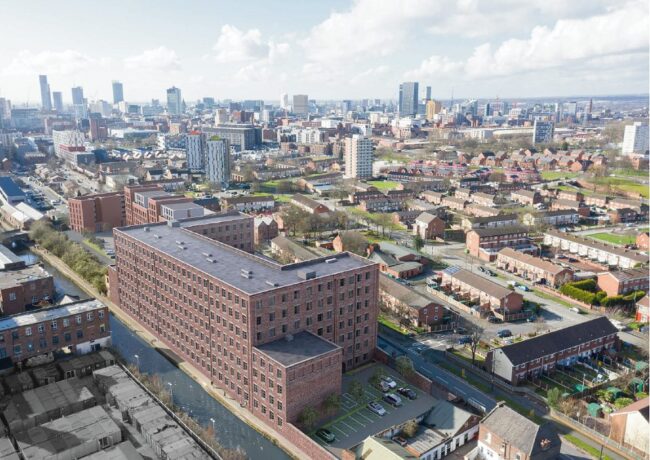Maryland’s £58m Brunswick Place approved
Manchester City Council signed off on the 277-home scheme at its planning meeting on Thursday after conducting a site visit.
The granting of planning permission did come with strings, however. It is dependent on a re-evaluation of the Maryland Securities scheme at an agreed point in time to determine its viability.
At present, Manchester planning development manager Dave Roscoe said the scheme’s profit is slated to be 18%, which puts it beneath the 20% threshold for providing affordable housing contributions. Brunswick Place, as it stands, does not include any social housing.
Hodder + Partners designed the scheme, which will see the historic mill buildings turned into 150 apartments with an assortment of townhouses in the surrounding area, as well as 20,000 sq ft of commercial space.
Roscoe told the councillors that the project could help the mill, noting that “we’ve lost far too many mill buildings in the Ancoats area”.
He went on to say that Brunswick Place “could be the most splendid [of the restored mills] if the right level of investment and refurbishment were undertaken”.
Maryland’s application also includes plans to create a public path through the site, connecting Bradford Road to the Ashton Canal towpath.
Brunswick Place had initially been deferred when it went before the planning committee, with councillors choosing to wait until they conducted a site visit to pass judgement. At the 23 September meeting, the scheme passed in a 6 to 2 vote.
Deloitte Real Estate is the planning consultant for the project and Stephen Levrant: Heritage Architecture advised on heritage.





Great news. Especially the bit about the footpath across the site. I hope that the land directly adjacent to the canal is opened up.
By Steve
This area of Manchester is becoming pretty impressive. I love what they have done with the canal at Butler street, the landscaping and the reintroduction of waterfowl. This is the natural ripple effect of Ancoats.
By Elephant
This area is one to watch. Between Ancoats, New Islington, New Cross, Piccadilly East and the new Co-Op Live, this area is really booming. Fantastic to see the regeneration of Miles Platting near its final phases and the protection of one of the city’s finest mills.
By Rapid transformation
It’s a shame that a profit margin of 18% is deemed sufficient to not allocate affordable housing. Is that a legal thing or a locally agreed thing? If the profit was *only* 10 or 15%, would that stop it being re-developed?
By Harpsicord
The mill element looks lovely but the new build blocks are terrible and no affordable housing is criminal.
By Observer
@Observer:
The 20% profit threshold represents the level of risk in the project, i.e. outturn profit could be lower. Therefore, if “only” a 18%/15%/10% profit margin were applied, there is a risk outturn profit is zero; few developers would be willing to proceed at that level of risk.
Heritage developments inherently more price-risk than standard.
By Viability